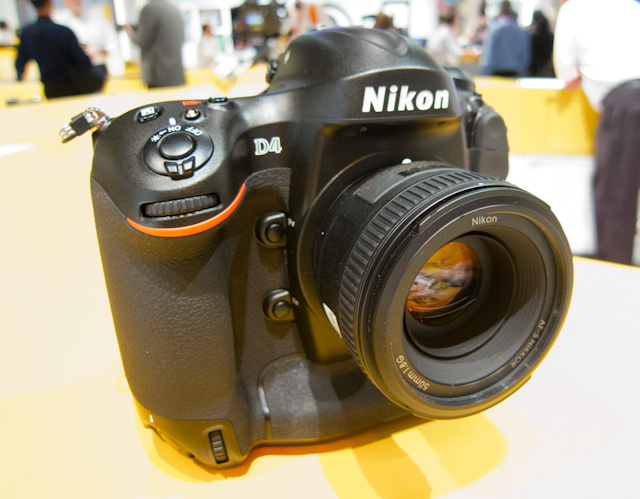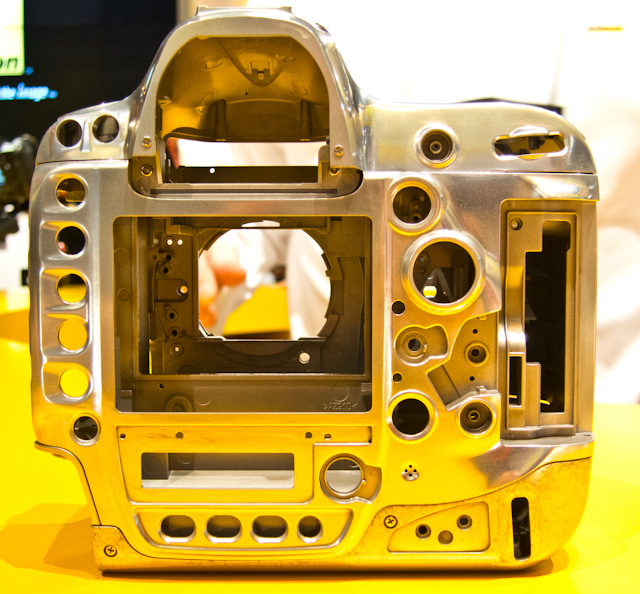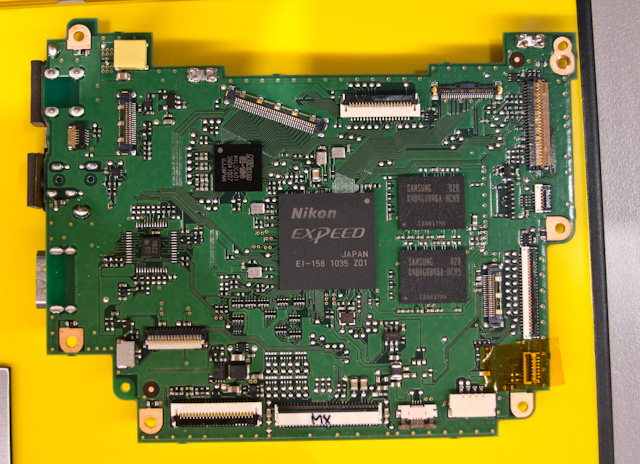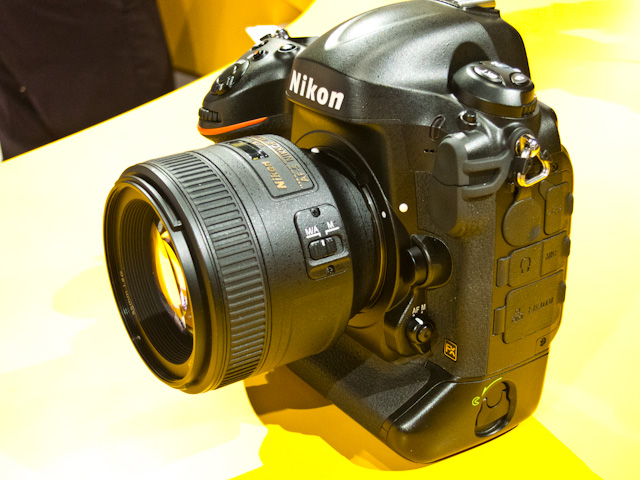
So, I hear that this new Nikon camera is a pretty big deal…
I had a few minutes to get acquainted with the new
Nikon D4 at
CES 2012, and I’m finally getting around to sharing my first impressions from this hands-on time.
As you probably know by now, the Nikon D4 is continuing down the same
path blazed by the D3 and D3s. It’s not a revolutionary change from
the D3s, but rather a solid evolution to the next generation of DSLRs.
The Nikon D4 remains conservative on resolution, bumping it up to only 16.1MP (up from 12.1MP on the D3s). Note that
Canon’s flagship 1D X
sports an 18MP sensor, which puts the cameras at what is practically
the same resolution for the sake of real world comparisons.
Of course, low light ISO performance has taken the limelight in
recent years when comparing cameras head-to-head. And, if early sample
images out of the gate are anything to go by, it looks like the Nikon D4
is set to carry on the tradition of the low light king amongst DSLRs.
Frankly though, I think the D4 and 1D X are going to be close to
splitting hairs again (as was the case with the Nikon D3s and Canon 1D
Mark IV . . . see my 3-part series:
1,
2,
3).
The Nikon D4 offers a sensitivity range of ISO 50-204,800 (with
expansion enabled). The official sample images at ISO 6400 look great.
I’m really interested to see what happens beyond that, because
my first look at the 1D X
showed some very impressive results at ISO 12800. In the end, I think
both Nikon and Canon’s new machines are going to give us a couple stops
advantage over their respective predecessors.
While Nikon says it has advanced the D4′s AF system to the “next
generation,” I’ll reserve judgment until I can comment on my actual
experience in a challenging AF environment. Of course, if it’s at least
as good as the D3s, we’re in for a real treat. In my opinion,
the D3s was the AF king
of the last generation. It will be interesting to see how the
advancements from the D3s AF system stacks up against the completely
redesigned AF system on the Canon 1D X.

When I first picked up the Canon 1D X, I was surprised by how much
heavier that it was over the Canon 1D Mark IV. When I picked up the
Nikon D4 for the first time, I was blown away by how light it was.

Then, when I got ahold of the D4′s frame all by its lonesome, I
realized where Nikon shaved the weight. The camera’s magnesium alloy
frame seems to weigh less than an origami recreation of the D4 would.
I’m convinced that frame must be part angel hair and part black magic to
be this light.

While there are many evolutionary advancements on the Nikon D4, the
most notable advancements have to be the shellacking that Nikon has
handed to Canon on the D4′s video capture feature set. Just three
months ago, Chuck Westfall told me that
the reason the Canon 1D X couldn’t offer a clean HDMI-output signal
was due to the processing power limitations. Those limitations include
a pair of Canon DIGIC 5+ processors, along with a separate DIGIC 4
processor that is solely dedicated to metering.

If the 1D X is so limited with 3 processors, then how is it that the
Nikon D4 spits out a clean HDMI feed with its EXPEED 3 processor? Is
Nikon really that far ahead of Canon in processor development? Or maybe
Canon is just playing coy and doesn’t want to chew into its diversified
market?
Another obvious improvement that Canon missed the mark with its 1D X
was the inclusion of a headphone output. While it’s true that most
serious HDSLR setups are arranged for dual-system capture, there are
many times when it’s ok to record on-board audio for production use.
The improvement of small shotgun mics like the
Rode VideoMic Pro and the coming
Rode VideoMic HD are making it more and more feasible to use on-camera audio.
With the D4, it’s clear that Nikon gets this HDSLR thing. That’s +2
for Nikon in the video department for those keeping score at home. And,
those aren’t little points either. These are two big things that HDSLR
shooters have been asking for since the Canon 5D Mark II busted onto
the scene 3.5 years ago. While Nikon is listening to the market in the
design of its flagship HDSLR, Canon has been caught asleep at the wheel.
One thing that I was surprised to hear was that Nikon has no “cinema”
style of camera presets. I was told that the “Neutral” profile could
be used, or that users could create their own. I imagine that it won’t
be long before someone cozies up to Nikon for some sort of official
partnership in a fashion similar to
Technicolor’s Cinestyle for Canon.
Either that, or someone will bust into an online forum with solid
breakdown in presets created with Nikon’s software to be loaded onto the
D4.
Another slick feature on the Nikon D4 is the stepless aperture
adjustment. I couldn’t really believe it until I saw it; however, it is
sexy. By making a selection in the menu system, you can pull the lens
iris via the depth-of-field preview and function buttons on the front of
the camera with your right hand. To my eye, the adjustments were
genuinely stepless. The big downside, however, is that you cannot adjust
the aperture in this manner when recording to onboard memory cards.
You can only make use of it when capturing to an external HDMI
recorder. A bit of a bummer for an otherwise killer feature.
For those thinking about an external recorder, the new
Blackmagic Hyperdeck Shuttle 2
looks like a great (and affordable) companion to the D4. It runs about
$350 and uses ordinary SSD drives as interchangeable storage. Other
options include the
Atomos Ninja 2, which has a built-in external monitor as part of the package.
Nikon finally has a resounding answer to all the HDSLR shooters wondering when Nikon was coming to the party.

That’s all I’ve got for now on the Nikon D4 until I get more time
with it. Lot’s more close-up images of the D4 in the gallery below.
The Nikon D4 is available from Photography Bay’s trusted retail partner, B&H Photo, at the following links:
Nikon D4 at B&H Photo
By making your photography purchases at B&H Photo through these
links, you are helping Photography Bay to continue bring quality camera
tests, news and reviews. Thanks for your continued support.
Via:http://www.photographybay.com
-
-
-
-
-
-
-
-
-
-
-
-













![*UPDATE* New High-End DSLR Later in February [CR3]](http://www.canonrumors.com/wp-content/themes/magnet/scripts/timthumb.php?src=http://www.canonrumors.com/wp-content/uploads/2011/01/canon5dmk211.jpg&a=t&h=200&w=475)
![*UPDATE* 5D Mark III – February 7, 2012 [CR2]](http://www.canonrumors.com/wp-content/themes/magnet/scripts/timthumb.php?src=http://www.canonrumors.com/wp-content/uploads/2012/01/5d3sm.jpg&a=t&h=200&w=475)


